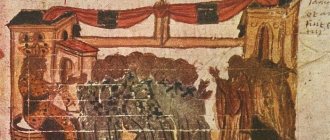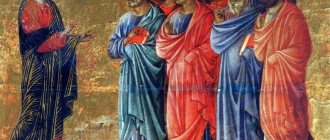Bible lessons
Published 02/18/2018
The article “Principles of Bible Interpretation” will help you become familiar with the golden rules of Bible interpretation, which will make your Bible study not only interesting, but also correct... It is important not only to read the Bible, but also to understand it correctly. Today we would like to introduce you to a chapter from Steve Kinnard's book.
Principles of Bible Interpretation
“God’s Word is in the Bible as the soul is in the body.” Peter Taylor Forsyth, Congregational theologian
When my family and I lived in Jerusalem for a year, I interacted with many archaeologists living there. I spoke with a geologist who was studying new data from the Hezekiah Tunnel at Siloam. I spoke with the chief archaeologist at the excavations of Palestinian Caesarea. I talked with the archaeologist who oversaw the work at Bet Shin during the summer. Archaeologists often encounter difficulties during excavations. They find data in separate layers of the earth that contradict existing theses. When they find themselves in such a dead end, they have a tried-and-true method for finding a solution to the dilemma—dig deeper. In archaeology, when you want an answer, you dig deeper.
The same applies to Bible study. When you discover material in a text that you don't understand, dig deeper. But what tools should we use to go deeper into the Bible? Below are four principles for interpreting the Bible to help you delve deeper into the text. Examples are provided to clarify these principles. Happy diving!
Interpretation of Holy Scripture by the Holy Fathers
There is a problem when people sometimes trust the name of this or that person more than the Bible. A great number of people today do not read or know the Scriptures. The interpretation of Holy Scripture by various people, be it the holy fathers or today's preachers, has become the main spiritual food for many. Many people believe that going to meetings and listening to sermons and liturgies is what believers are told to do.
This is what believers are told to do at the meeting - to serve each one with the gift that they have received. Whoever has teaching - glory to God; whoever has revelation, tongue, prophecy - everything should carry edification. And let me emphasize – NOT FOR THE REASON. We are spiritual beings. Our spirit must receive food NOT FROM a person’s THOUGHTS, not from a joke show, not from a religious activity, but from the Holy Spirit.
The First Principle of Bible Interpretation: Interpret a Passage in the Light of Its Context
A passage of Scripture must always be viewed in its context. An old country preacher once told me, “A passage taken out of context is a cop-out.”1 You can prove anything by taking passages out of context. You may have heard the story of the man who told God he would open his Bible and point his finger at three passages. No matter what those passages said, the man was going to prove his faith in God by immediately submitting to those three random passages. On his first attempt, his finger pointed to a passage that says Judas “went out and went and hanged himself.” The second opened: “Go and do the same.” The third attempt pointed to the ominous words: “What are you doing, do it quickly.” Moral of the story: We choke ourselves by taking passages out of context.
Near context
When reading a passage, first look at the passages immediately surrounding the verse in question. This simple procedure will often help you understand the meaning of a verse. Isaiah 58:11 can be used to say that if a person is part of God's kingdom, his troubles will end. I have heard religious Israelis use similar verses to argue that God himself decreed that the Israelis should control the territory of Palestine.
“The Lord will always guide you, He will satisfy your souls in dry lands and give you strength, You will be like a garden by the water, like a stream that never runs dry.”2
But when you look at the immediate context, you will see that this promise is based on the conditions set out in verses 9-10. A careful reading of the immediate context may help clarify this verse:
“You should no longer bring trouble to people, you should not blame others and say bitter words. You must feel compassion for the hungry and give them bread, You must help people in distress, Then your light will shine in the darkness, your sorrow will pass, and you will shine like the noonday sun” (Isaiah 58:9-10).
Distant context
The "distant context" is the context of the entire Bible. Consider how this passage or verse fits into its overall context. Verses 16-17 from 1 Thessalonians 4 are often used as evidence that there will be two resurrections, one for the righteous and one later for the wicked. They are also used as evidence that after the first resurrection, those remaining on earth will face a time of trial and tribulation. However, it is necessary to consider both the near and distant context of these verses.
In the immediate context, we see that Paul is addressing the question raised by the early church about what would happen to their dead brothers and sisters. He says that those who have died in Christ will be resurrected first. Then all who are alive will be taken up with them in the clouds. In other words, there will be one resurrection for the dead and the living. First the dead will be resurrected, then the living will be taken to meet God. As we continue to read the following verses (5:1-3), we see that on that same “day of the Lord” “suddenly destruction overtakes them (i.e. the wicked). In context, it is clear that the resurrection of the righteous and the judgment of the wicked will take place on the same day and that no one will remain on earth. Now compare this passage with its distant context in the rest of the Bible. Jesus describes the resurrection in John 5:28-29 as one resurrection of both the wicked and the righteous. Jesus says:
“Do not be surprised at this, for the time is approaching when all who lie in their graves will hear the voice of the Son of Man and will rise from their graves. Those who have done righteous deeds will be resurrected to life, but those who have done evil will be resurrected to be judged" (John 5:28-29).
The distant context of the passage supports the claim that there will be one resurrection, not two. Therefore, 1 Thessalonians 4:16-17 must fit into the context of the rest of the Bible.
When we talk about viewing Scripture in the light of its distant context, we are arguing for Scripture to interpret Scripture. Here are some basic principles.
- No passage of Scripture can be interpreted so as to contradict another. Always interpret a less clear passage in the light of a clearer one.
- Read the Bible widely and study it regularly so that you know its main ideas.
- Perhaps the most important question to continually ask when studying Scripture is the question of context: “What does this passage mean in its context?” If you answer this question, the most difficult verses will become clear.
Listen to interpretation of Holy Scripture
Of course, the choice is yours - whether or not to listen to those who claim to be an interpreter or teacher. But remember that the Bible calls us
Testing ministers is not a disgrace or shame. This is a duty, a matter for the Church of Christ. The Ephesian church considered this normal. Paul considered it normal to tell the Church about what teachers should be and what to teach; John denounced those who behaved incorrectly in the Church.
The Second Principle of Bible Interpretation: Interpret According to the Correct Meaning of the Words
Words can have multiple meanings. For example, the word "heaven" can mean the sky above us or imply an eternal home for the righteous. To interpret Scripture correctly, we must understand the correct definition of the words in the passage.
Unlawful change of concept
Matthew 24:34 is a key verse for understanding Jesus' teaching about the end times. If you study Matthew 24 carefully, you will see that Jesus is answering two questions: (1) what will be the signs of the destruction of the temple in Jerusalem; and (2) what will be the signs of the end time? Jesus answers the first question and then moves on to answer the second. Verse 34 is a transition from the first question to the second. Jesus says: “Truly I say, all these things will happen within the lifetime of this generation.” “Generation” is a period of thirty to forty years. This is how the word is used consistently throughout the Bible. All the signs that precede this verse—wars and rumors of war, famines and earthquakes—refer to the destruction of the temple in Jerusalem, which occurred in 70 AD.
Proponents of the theory of the thousand-year reign of Christ3 attribute the above-mentioned signs to the second question about the end of times. They constantly monitor political events around the world, trying to predict when Jesus will appear and establish what they call His "millennial kingdom" on earth. However, verse 34 gives them a problem. If the signs preceding verse 34 refer to the generation of the first disciples, then they cannot be applied to the end of time. So they gave a different definition to the word generation. For them, “generation” becomes a distribution of historical periods4. They reject the usual, normal definition of a term (a definition that makes sense in the context of Scripture) and revise it to fit their doctrine. This is an example of how wordplay can lead to false doctrine. But what are the basic principles for defining words?
Context, context, context
Often the context (the words immediately preceding or following the word in question) gives the word its definition. For example, 2 Timothy 3:16-17 reads like this:
All Scripture is inspired by God and is useful for teaching, for reproof, for correction, for instruction in righteousness, so that the man of God may be complete, equipped for every good work.
What does the word “perfect”5 mean here? The usual definition would be “flawless, faultless.” Does the Bible Make Us Inerrant? No—even with the Bible, we still sin and are unworthy of God's glory. Context determines the word. The verse says, “perfect… equipped for every good work.” In context, the word “perfect” means that the Bible fully equips us to follow God. The Modern Version6 makes this clear by rendering the phrase, “...so that the man of God may be able to do all that is required of him, and be equipped to do good works.” As you can see, looking at context helps define a word.
Parallelism
Hebrew poetry was built more on parallel imagery than on rhyme. The two most common types of parallelism in Scripture are synonymous and antithetical parallelism.
Synonymous parallelism is when two similar ideas are expressed together. One idea follows closely after another. The second clarifies and expands the first. For example, Psalm 7:14 says: “He has taken the weapon of death, he has prepared flaming arrows!”7. The first idea, “weapons of death,” is explained and defined by the second parallel idea, “burning arrows.” Although this passage does not present a deep doctrinal issue, it does show the thinking of the Jewish authors, who typically expressed their ideas through parallelism.
Opposite parallelism is when two opposing ideas are expressed in parallel. One idea helps characterize another by stating the opposite of the previous one. For example, Proverbs 15:1 says, “A gentle answer calms anger, but a harsh answer kindles it.” The second idea reflects the opposite of the first. In doing so, it helps to define and explain what is stated in the first idea. The book of Proverbs contains many examples of such parallelism.
Another example of opposite parallelism is found in Genesis 29:17, which compares Laban's daughters Leah and Rachel. In the Synodal translation they are described in this way: “Leah was weak-eyed, but Rachel was beautiful in form and beautiful in face”8. What does “weak eyes” mean? We don't usually use this term to describe people. If you look at the description of Rachel, you will see the opposite of weak eyes: “beautiful in form and beautiful in face.” "Weak eyes" is a euphemism for "not beautiful." This was a delicate way of saying that Leah was not a pretty sister; but Rachel was.
Important Terms
- " Hermeneutics " is the study of the principles of correct interpretation of Scripture. In other words, hermeneutics is the study of how to interpret.
- " Exegesis " is the practical application of the principles of correct Biblical interpretation. This should be what we do every time we study the Bible.
- “ Exposition ” is the communication of the interpretation of Scripture to others. This happens whenever we preach or teach the scriptures.
Understanding Hebrew parallelism is very helpful in understanding Scripture. These were simple, easy examples that did not involve doctrine. But there are other examples that show how understanding Jewish parallelism can help clarify important issues in Scripture. What is meant by the word “faith” in the Gospel of John? In the modern world, "faith" means accepting something as true. Does John define “faith” in the same way? He uses Hebrew parallelism in John 3:36 to clarify his meaning of “faith.” The Synodal translation reflects this less clearly:
He who believes in the Son has eternal life, and he who does not believe in the Son will not see life, but the wrath of God remains on him.
Consider the modern translation of RBO, which is much closer to the Greek meaning:
He who believes in the Son has gained eternal life, but he who does not obey the Son will never see life: God's wrath will be upon him forever.
John expresses his point through the opposite parallelism - if you believe, you will have eternal life, but if you do not obey, you will not see life. The opposite parallel between faith and disobedience.
Explanatory BibleNew Testament
The word “canon” (κανών) originally meant “reed”, and then began to be used to designate what should serve as a rule, a pattern of life (Gal. 6:16; 2 Cor. 10:13–16). The Church Fathers and Councils used this term to designate a collection of sacred, inspired writings. Therefore, the canon of the New Testament is the collection of the sacred inspired books of the New Testament in its present form3.
What was the primacy of the Church guided by when it accepted this or that sacred New Testament book into the canon? First of all, the so-called historical
by legend.
They investigated whether this or that book had actually been received directly from an apostle or an apostolic co-worker, and, after a strict study, they included this book among the inspired books. But at the same time, they also paid attention to whether the teaching contained in the book in question was consistent, firstly, with the teaching of the entire Church and, secondly, with the teaching of the apostle whose name this book bore. This is the so-called dogmatic
tradition. And it has never happened that the Church, once recognizing a book as canonical, subsequently changed its view of it and excluded it from the canon. If individual fathers and teachers of the Church even after this still recognized some New Testament writings as inauthentic, then this was only their private view, which should not be confused with the voice of the Church. In the same way, it has never happened that the Church first did not accept any book into the canon, and then included it. If some canonical books are not indicated in the writings of the apostolic men (for example, the Epistle of Jude), this is explained by the fact that the apostolic men had no reason to quote these books.
Thus, the Church, through critical examination, on the one hand, eliminated from general use those books that unlawfully used the authority of truly apostolic works, on the other hand, established as a general rule that in all churches those books that, perhaps, were recognized as truly apostolic were unknown to some private churches. From this it is clear that from the Orthodox point of view one can speak not of the “formation of a canon,” but only of the “establishment of a canon.” The Church did not “create anything out of itself” in this case, but only, so to speak, stated precisely verified facts of the origin of the sacred books from the famous inspired men of the New Testament.
This “establishment of the canon” continued for a very long time. Even under the apostles, there undoubtedly existed something like a canon, which can be confirmed by the Apostle Paul’s reference to the existence of a collection of the words of Christ and the Apostle Peter’s reference to the collection of Paul’s Epistles (2 Pet. 3:15-16). According to some ancient interpreters, for example Theodore of Mopsuestia, and new ones, for example Archpriest. A.V. Gorsky, the Apostle John the Theologian worked the most in this matter (“Addition to the works of the holy fathers.” T. 24. pp. 297–327).
But actually the first
The period of canon history is the period of apostolic and Christian apologists, lasting approximately from the end of the 1st century until the year 170. During this period, we find, for the most part, quite clear indications of the books included in the New Testament canon, but the writers of this period still very rarely directly indicate from which holy book they take this or that passage, so that we find among them the so-called “ dumb quotes." Moreover, as Barth says in his “Introduction to the New Testament” (ed. 1908, p. 324), in those days spiritual gifts were still in full bloom and there were many inspired prophets and teachers, so look for primary sources for your teachings writers of the 2nd century could not in books, but in the oral teachings of these prophets and in general in oral church tradition.
In the second
period, lasting until the end of the 3rd century, more definite indications appear of the existence of the composition of the New Testament sacred books accepted by the Church. Thus, a fragment found by the scientist Muratorius in the Milan library and dating back to approximately 200–210. according to R.H., gives a historical overview of almost all New Testament books: only the Epistle to the Hebrews, the Epistle of James and the 2nd Epistle of the Apostle Peter are not mentioned in it. This fragment testifies, of course, mainly to the composition of the canon established by the end of the 2nd century in the Western Church. The state of the canon in the Eastern Church is evidenced by the Syriac translation of the New Testament, known as the Peshitta. This translation mentions almost all of our canonical books, with the exception of the 2nd Epistle of the Apostle Peter, the 2nd and 3rd Epistles of John, the Epistle of Jude and the Apocalypse. Tertullian testifies to the state of the canon in the Carthaginian Church. He certifies the authenticity of the Epistle of Jude and the Apocalypse, but does not mention the epistles of the Apostle James and the 2nd Epistle of the Apostle Peter, and attributes the Epistle to the Hebrews to Barnabas. Saint Irenaeus of Lyons is a witness to the beliefs of the Gallic Church. According to him, in this Church almost all of our books were recognized as canonical, with the exception of the 2nd Epistle of the Apostle Peter and the Epistle of Jude. The Epistle to Philemon is also not quoted. Saints Clement of Alexandria and Origen testify to the beliefs of the Alexandrian Church. The former used all the New Testament books, and the latter recognizes the apostolic origin of all our books, although he reports that regarding the 2nd Epistle of Peter, the 2nd and 3rd Epistles of John, the Epistle of James, the Epistle of Jude and the Epistle to the Hebrews there were disagreements in his time .
Thus, in the second half of the 2nd century, the following sacred books were undoubtedly recognized as inspired apostolic works throughout the Church: the four Gospels, the book of the Acts of the Apostles, the 13 Epistles of the Apostle Paul, 1 John and 1 Peter. Other books were less common, although they were recognized by the Church as authentic.
On the third
period, extending to the second half of the 4th century, the canon is finally established in the form in which it currently exists. Witnesses of the faith of the entire Church here are Eusebius of Caesarea, Saints Cyril of Jerusalem, Gregory the Theologian, Athanasius of Alexandria, Basil the Great, and others. The first of these witnesses speaks most thoroughly about the canonical books. According to him, at that time some books were recognized by the entire Church (τὰ ὁμολογούμενα), namely, the four Gospels, the book of Acts, the 14 Epistles of the Apostle Paul, 1 Peter and 1 John. Here he includes, however with a reservation (“if it pleases”), the Apocalypse of John. Then he has a class of controversial books (ἀντιλεγόμενα), divided into two categories. In the first category he places books that are accepted by many, although controversial. These are the Epistles of James, Jude, 2 Peter and 2 and 3 John. To the second category he includes forged books (νόθα), such as the “Acts of Paul” and others, as well as, “if it pleases,” the Apocalypse of John. He himself considers all our books to be genuine, even the Apocalypse. The list of books of the New Testament found in the Easter letter of St. received a decisive influence in the Eastern Church. Athanasius of Alexandria (367). Having listed all 27 books of the New Testament, St. Athanasius says that only in these books is the teaching of piety proclaimed and that nothing can be taken away from this collection of books, just as nothing can be added to it. Taking into account the great authority that St. had in the Eastern Church. Athanasius, this great fighter against Arianism, we can confidently conclude that the canon of the New Testament he proposed was accepted by the entire Eastern Church, although after St. Athanasius did not follow any conciliar decision regarding the composition of the canon. However, it should be noted that St. Athanasius points out two books that, although not canonized by the Church, are intended for reading by those entering the Church. These books are the teachings of the (twelve) apostles and the shepherd (Hermas). He rejects everything else as heretical fabrication (i.e., books falsely called apostolic).
In the Western Church, the canon of the New Testament in its present form was finally established at the Councils in Africa - the Council of Hippo (393) and the two Councils of Carthage (397 and 419). The canon of the New Testament adopted by these Councils was sanctioned by the Roman Church by decree of Pope Gelasius (492–496).
Those Christian books that were not included in the canon, although they expressed claims to this, were recognized as apocryphal and destined almost for complete destruction4.
Fleshly minded and spiritually minded
This is why SOUL people do not understand the things of the Spirit. They need their MIND to understand everything. And if not, they will not be at such meetings, they will leave them to where “everything is clear.” And, unfortunately, most of them today are in the world, listening to the world, thinking and speaking in a worldly way. Everything there is clear and “natural” to them. There is no need to reason, rejecting your mind, there is no need to pray and be jealous in order to serve.
Everything is simpler in the world. There are educational institutions, there are interpretations of the Bible, for every taste, there is an organization, there is a worldly structure. But the Word calls those who strive to heaven for another. To something completely different.









